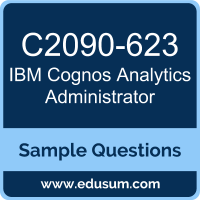01. An administrator wants to exclude Request level logging details from being captured. Which logging level must be set?
a) Basic logging level
b) Trace logging level
c) Verbose logging level
d) Request logging level is turned on by default
02. In a multi-server environment, an administrator wants to ensure that items in the Content Manager Cache service are re-validated every thirty seconds. Which option would accomplish this?
a) Set the memory limit of the Content Manager Cache service to 30000.
b) Set the DISP.contentManagerCacheService.accountInactivityTimer property to 30000.
c) Set the DISP.contentManagerCacheService.cacheValidatorTimetoLive property to 30000.
d) Set the DISP.contentManagerCacheService.cacheValidatorTimetoLinger property to 30000.
03. An administrator needs to setup security for a newly installed environment. Which of the following is a valid step?
a) Remove the default authentication provider.
b) Enable anonymous access for selected users, groups, or roles.
c) Delete the Everyone group to limit access to the environment for selected users, groups, and roles.
d) Add trusted users, groups, or roles to the System Administrators role, and then remove the Everyone group from the role.
04. An administrator is implementing security by managing and working with the Cognos namespace. Which statement is true?
a) To gain access to IBM Cognos Analytics, users can log on to the Cognos namespace.
b) Create domain users in the Cognos namespace to avoid cluttering the existing authentication provider.
c) User-defined groups and roles must be created in a 3rd-party authentication provider and cannot be created in the Cognos namespace.
d) Although the use of the predefined and built-in groups and roles within the Cognos namespace is optional, the Cognos namespace cannot be deleted.
05. What is the role of Cognos Access Manager (CAM)?
a) To serve as the relational database that stores user data.
b) To implement authentication, authorization, and encryption.
c) To start all services that have been enabled and configured.
d) To route requests from the gateway to local services for execution.
06. An administrator needs to add users from multiple authentication providers to a single role. What needs to be done?
a) Log on to each of the namespaces before starting.
b) Add external namespaces to the Cognos namespace manually.
c) Add the users to a Cognos group, then add the group to the Cognos role.
d) Import the users to the Cognos namespace first, then add the users to the Cognos role.
07. Why would an administrator use IPF (Indication Processing Facility) logging?
a) As a wrapper tool for gateway related errors.
b) To process the audit logging data and write it to the audit database.
c) As a wrapper for log4j to configure what information is written to log files.
d) For tracing performance and communication between XQE and the BIBus.
08. An administrator would like to log the activity for a single user. Which action is required?
a) Use the Remote Process service for Java Management Extensions (JMX).
b) Modify the ipfcogconfig.xml file in the bin64 directory.
c) Set the Report service logging to Trace.
d) Set the advanced parameter RSVP.REPORTUSER.LOG for the Report service.
09. An administrator is evaluating system status using the Scorecard pane on the Status > System page in the IBM Cognos Administration console. Which statement is true?
a) If a service is disabled in IBM Cognos Configuration, it is listed in the Scorecard pane.
b) The status that is displayed for each entry reflects the lowest status for all child entries.
c) A status of Available is displayed when at least 80% of the child entries have a status of Available.
d) A status of Unavailable is displayed when at least 80% of the child entries have a status of Unavailable.
10. Which component stores and retrieves application data, including report specifications, report output, security, and configuration data?
a) Gateway
b) Dispatcher
c) Content Manager
d) Presentation service
 The purpose of this Sample Question Set is to provide you with information about the IBM Cognos Analytics Administrator V11 exam. These sample questions will make you very familiar with both the type and the difficulty level of the questions on the C2090-623 certification test. To get familiar with real exam environment, we suggest you try our Sample IBM Cognos Analytics Administrator Certification Practice Exam. This sample practice exam gives you the feeling of reality and is a clue to the questions asked in the actual IBM Certified Administrator - IBM Cognos Analytics Administrator V11 certification exam.
The purpose of this Sample Question Set is to provide you with information about the IBM Cognos Analytics Administrator V11 exam. These sample questions will make you very familiar with both the type and the difficulty level of the questions on the C2090-623 certification test. To get familiar with real exam environment, we suggest you try our Sample IBM Cognos Analytics Administrator Certification Practice Exam. This sample practice exam gives you the feeling of reality and is a clue to the questions asked in the actual IBM Certified Administrator - IBM Cognos Analytics Administrator V11 certification exam.